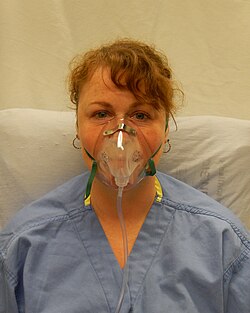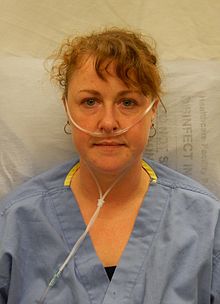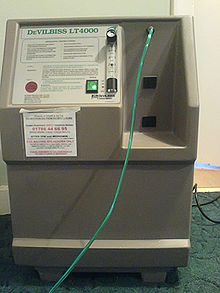ഓക്സിജൻ തെറാപ്പി
 A person wearing a simple face mask | |
| Clinical data | |
|---|---|
| AHFS/Drugs.com | FDA Professional Drug Information |
| Routes of administration | inhaled |
| Identifiers | |
| CAS Number | 7782-44-7 |
| ATC code | V03AN01 (WHO) |
| ChemSpider | none |
| UNII | S88TT14065 |
| Synonyms | supplemental oxygen, enriched air |
| Chemical data | |
| Formula | O2 |
ഓക്സിജൻ ഒരു ചികിത്സ പോലെ പ്രയോജനപ്പെടുത്തുന്നതാണ് ഓക്സിജൻ തെറാപ്പി എന്നറിയപ്പെടുന്നത്. [1] രക്തത്തിലെ കുറഞ്ഞ ഓക്സിജൻ നില, കാർബൺ മോണോക്സൈഡ് വിഷാംശം, ക്ലസ്റ്റർ തലവേദന, അനസ്തേഷ്യ നൽകുമ്പോൾ ഓക്സിജൻ അളവ് നിലനിർത്തൽ എന്നിവ ഇതിൽ ഉൾപ്പെടാം. [2] കഠിനമായ ക്രോണിക് ഒബ്സ്ട്രക്ടീവ് പൾമൊണറി ഡിസീസ് (സിപിഡി) അല്ലെങ്കിൽ സിസ്റ്റിക് ഫൈബ്രോസിസ് പോലുള്ള ദീർഘകാലരോഗമുള്ളവരിൽ ഓക്സിജൻ തെറാപ്പി ഉപയോഗപ്രദമാണ്. [3] നാസൽ കാനുല, ഓക്സിജൻ മാസ്ക്, ഹൈപ്പർബാറിക് ചേമ്പർ തുടങ്ങിയ നിരവധി മാർഗങ്ങളിലൂടെ ഓക്സിജൻ നൽകാം. [4] [5]
സാധാരണ ഉപാപചയത്തിന് ഓക്സിജൻ ആവശ്യമാണ്. [6] അമിതമായ ഓക്സിജൻ വിഷതുല്യമാണ് . ഇതുമൂലം ശ്വാസകോശ തകരാറുകളോ ശ്വസനപരാജയം തന്നേയോ സംഭവിച്ചേക്കാം. [2] ഉയർന്ന ഓക്സിജന്റെ സാന്ദ്രത തീപിടുത്തസാധ്യത വർദ്ധിപ്പിക്കുന്നു. [1] ഓക്സിജൻ പൂരിതം എത്രയായിരിക്കേണമെന്നത് രോഗാവസ്ഥയെ ആശ്രയിച്ചിരിക്കുന്നു. മിക്ക സാഹചര്യങ്ങളിലും 94–96% സാച്ചുറേഷൻ ശുപാർശ ചെയ്യുന്നു. അതേസമയം കാർബൺ ഡൈ ഓക്സൈഡ് പിടിച്ചു നിറുത്തുന്ന പ്രവണതയുള്ളവരിൽ പൂരിതം 88–92% ആണ് അഭികാമ്യം. കാർബൺ മോണോക്സൈഡ് വിഷാംശം ഉള്ളവരിലും ഹൃദയസ്തംഭന സാധ്യത ഉള്ളവരിലും ഓക്സിജൻറെ അളവ് കഴിയുന്നത്ര ഉയർന്നതായിരിക്കണം. [7] അന്തരീക്ഷവായുവിൽ 21% ഓക്സിജനാണ്, ഓക്സിജൻ തെറാപ്പിയിൽ ഇത് 100% വരെ വർദ്ധിപ്പിക്കുന്നു. [8]
വൈദ്യശാസ്ത്രത്തിൽ ഓക്സിജന്റെ ഉപയോഗം 1917 ഓടെ സാധാരണമായി. [9] [10] ലോകാരോഗ്യ സംഘടനയുടെ അവശ്യ മരുന്നുകളുടെ പട്ടികയിൽ ഇതുൾപ്പെടുന്നു. [11] ഹോം ഓക്സിജൻ പലരാജ്യങ്ങളിലും വിലയേറിയതായിത്തീർന്നിട്ടുണ്ട്. [3] ഓക്സിജൻ ടാങ്കുകൾ അല്ലെങ്കിൽ ഓക്സിജൻ കോൺസെൻട്രേറ്റർ ആയാണ് ഇത് നൽകുന്നത്. [1] വികസിത രാജ്യങ്ങളിലെ ആശുപത്രികളിൽ നൽകുന്ന ഏറ്റവും സാധാരണമായ ചികിത്സയാണ് ഓക്സിജൻ എന്ന് വിശ്വസിക്കപ്പെടുന്നു. [12]
മെഡിക്കൽ ഉപയോഗങ്ങൾ[തിരുത്തുക]




അനുബന്ധ ഓക്സിജന്റെ ഒരു സാധാരണ ഉപയോഗം ക്രോണിക് ഒബ്സ്ട്രക്റ്റീവ് പൾമണറി ഡിസീസ്, പുകവലിയുടെ ഒരു ദീർഘകാല പ്രഭാവം മൂലം ക്രോണിക് ബ്രോങ്കൈറ്റിസ് അല്ലെങ്കിൽ എംഫിസീമ എന്നിവയുള്ളവരിലാണ്.[13] [14] [15]
നിശിത അവസ്ഥ[തിരുത്തുക]
ആശുപത്രിയിലും അടിയന്തിര മെഡിക്കൽ സേവനങ്ങളിലും അല്ലെങ്കിൽ വിപുലമായ പ്രഥമശുശ്രൂഷ നൽകുന്നവരിലും ഓക്സിജൻ അടിയന്തിര വൈദ്യത്തിൽ വ്യാപകമായി ഉപയോഗിക്കുന്നു.[16] [17] കടുത്ത അസുഖമുള്ളവരിൽ ഓക്സിജന്റെ അമിത ഉപയോഗം മരണ സാധ്യത വർദ്ധിപ്പിക്കുന്നു. [18]
പാർശ്വ ഫലങ്ങൾ[തിരുത്തുക]
പല ഇ.എം.എസ് പ്രോട്ടോക്കോളുകളും ഓക്സിജൻ തടഞ്ഞുവയ്ക്കരുതെന്ന് സൂചിപ്പിക്കുന്നു. എന്നിരുന്നാലും, ഓക്സിജൻ തെറാപ്പി ഒരു വ്യക്തിയുടെ അവസ്ഥയെ പ്രതികൂലമായും ബാധിക്കാം. [19]
പാരക്വാട്ട് വിഷം ഉള്ള ഒരാൾക്ക് കടുത്ത ശ്വാസകോശ സംബന്ധമായ അസുഖമോ ശ്വാസകോശ അറസ്റ്റോ ഇല്ലെങ്കിൽ ഒരിക്കലും ഓക്സിജൻ നൽകരുത്, കാരണം ഇത് വിഷാംശം വർദ്ധിപ്പിക്കും. [20] ബ്ലോമൈസിൻ ചികിത്സയുടെ ഫലമായി ശ്വാസകോശത്തിലെ ഫൈബ്രോസിസ് അല്ലെങ്കിൽ മറ്റ് ശ്വാസകോശ തകരാറുകൾ ഉള്ളവർക്ക് ഓക്സിജൻ തെറാപ്പി ശുപാർശ ചെയ്യരുത്. [21]
കണ്ണിന് തടസ്സമുണ്ടാക്കുന്ന പുതിയ രക്തക്കുഴലുകളുടെ വളർച്ചയെ പ്രോത്സാഹിപ്പിക്കുന്നതിലൂടെ ഉയർന്ന അളവിലുള്ള ഓക്സിജൻ ശിശുക്കൾക്ക് അന്ധതയുണ്ടാക്കാം. ഇത് റെറ്റിനോപ്പതി ഓഫ് പ്രീമാച്യുരിറ്റിക്ക് കാരണമാകാം
ഓക്സിജന് രക്തചംക്രമണവ്യൂഹത്തിൽ വാസോകോൺസ്ട്രിക്റ്റീവ് ഇഫക്റ്റുകൾ ഉണ്ട്, ഇത് പെരിഫറൽ രക്തചംക്രമണം കുറയ്ക്കുന്നു, കൂടാതെ സ്ട്രോക്കിന്റെ സാദ്ധ്യത വർദ്ധിപ്പിക്കുമെന്ന് ഒരിക്കൽ കരുതിയിരുന്നു. എന്നിരുന്നാലും, വ്യക്തിക്ക് അധിക ഓക്സിജൻ നൽകുമ്പോൾ, ഹെൻറിയുടെ നിയമമനുസരിച്ച് അധിക ഓക്സിജൻ പ്ലാസ്മയിൽ ലയിക്കുന്നു. 1990 മുതൽ, ലോകമെമ്പാടുമുള്ള ഹൃദയാഘാത ചികിത്സകളിൽ ഹൈപ്പർബാറിക് ഓക്സിജൻ തെറാപ്പി ഉപയോഗിക്കുന്നു. അപൂർവ സന്ദർഭങ്ങളിൽ, ഹൈപ്പർബാറിക് ഓക്സിജൻ തെറാപ്പി സ്വീകരിക്കുന്ന ആളുകൾക്ക് പേശിവലിവുണ്ടാകാറുണ്ട്. [22] [23]
വർഷങ്ങളായി ഡൈവിംഗ് പരിക്കുകൾക്ക് അടിയന്തിര ചികിത്സയായി ഓക്സിജൻ പ്രഥമശുശ്രൂഷ ഉപയോഗിക്കുന്നു. [24] [25] [26] [27]
വിട്ടുമാറാത്ത ശ്വാസകോശരോഗം[തിരുത്തുക]
എംഫിസെമ പോലുള്ള വിട്ടുമാറാത്ത ശ്വാസകോശ സംബന്ധമായ അസുഖമുള്ളവരിൽ ശ്വസന പരിചരണം ആവശ്യമാണ്. അത്തരം ആളുകളിൽ, കാർബൺ ഡൈ ഓക്സൈഡ് അടിഞ്ഞുകൂടുകയും അനുബന്ധ ഓക്സിജൻ നൽകിയാൽ പി.എച്ച് കുറയുകയും അവരുടെ ജീവൻ അപകടത്തിലാക്കുകയും ചെയ്യും. ഇത് പ്രാഥമികമായി വെന്റിലേഷൻ-പെർഫ്യൂഷൻ അസന്തുലിതാവസ്ഥയുടെ ഫലമാണ്. [28]
തീ അപകടസാധ്യത[തിരുത്തുക]
ഓക്സിജന്റെ ഉയർന്ന സാന്ദ്രത ഉറവിടങ്ങൾ ദ്രുതഗതിയിലുള്ള ജ്വലനത്തെ പ്രോത്സാഹിപ്പിക്കുന്നു. ഓക്സിജൻ തനിയെ കത്തുന്നതല്ല, പക്ഷേ തീയിൽ സാന്ദ്രീകൃത ഓക്സിജൻ ചേർക്കുന്നത് സാധാരണ അവസ്ഥയിൽ താരതമ്യേന നിഷ്ക്രിയമായിരിക്കുന്ന വസ്തുക്കളുടെ ജ്വലനത്തിന് ഇത് സഹായിക്കും. ശുദ്ധമായ ഓക്സിജൻ ഉപയോഗിച്ച് തീപിടുത്തമുണ്ടായതിന്റെ അറിയപ്പെടുന്ന ഒരു ഉദാഹരണം 1967 ജനുവരിയിൽ അപ്പോളോ 1 ബഹിരാകാശവാഹനത്തിൽ സംഭവിച്ചു. [29]
വാതക, ദ്രാവക ഓക്സിജൻ സംഭരിക്കുന്നതിനും കൈമാറുന്നതിനും ഉപയോഗിക്കുന്ന സ്റ്റീൽ പൈപ്പുകളും സംഭരണ പാത്രങ്ങളും ഒരു ഇന്ധനമായി പ്രവർത്തിക്കും; ഉയർന്ന മർദ്ദമുള്ള അന്തരീക്ഷത്തിൽ ഉയർന്ന സാന്ദ്രത ഉള്ള ഓക്സിജൻ എണ്ണയും ഗ്രീസും പോലുള്ള ഹൈഡ്രോകാർബണുകളെ സ്വമേധയാ ജ്വലിപ്പിക്കും, ഇത് തീയോ സ്ഫോടനമോ ഉണ്ടാക്കുന്നു. ദ്രുതഗതിയിലുള്ള സമ്മർദ്ദം മൂലമുണ്ടാകുന്ന താപം ജ്വലന ഉറവിടമായി വർത്തിക്കുന്നു. ഇക്കാരണത്താൽ, സംഭരണ പാത്രങ്ങൾ, റെഗുലേറ്ററുകൾ, പൈപ്പിംഗ്, ഉയർന്ന സാന്ദ്രതയുള്ള ഓക്സിജനുമായി ഉപയോഗിക്കുന്ന മറ്റേതെങ്കിലും ഉപകരണങ്ങൾ എന്നിവയിലും കൂടുതലുള്ള ഏതൊരു സാന്ദ്രതയും അപകടസാധ്യത വർധിപ്പിക്കുന്നു.
സംഭരണവും ഉറവിടങ്ങളും[തിരുത്തുക]


രാസപ്രവർത്തനവും അംശികസ്വേദനനും ഉൾപ്പെടെ നിരവധി മാർഗ്ഗങ്ങളിലൂടെ ഓക്സിജനെ വേർതിരിക്കാം, തുടർന്ന് അവ ഉടനടി ഉപയോഗിക്കുകയോ ഭാവിയിലെ ഉപയോഗത്തിനായി സൂക്ഷിക്കുകയോ ചെയ്യുന്നു. ഓക്സിജൻ തെറാപ്പിയുടെ പ്രധാന ഉറവിടങ്ങൾ ഇവയാണ്:
- ലിക്വിഡ് സ്റ്റോറേജ് - ആവശ്യമുള്ളതുവരെ ലിക്വിഡ് ഓക്സിജൻ ശീതീകരിച്ച ടാങ്കുകളിൽ സൂക്ഷിക്കുന്നു
- കംപ്രസ്സ് ഗ്യാസ് സംഭരണം - ഓക്സിജൻ വാതകം ഒരു ഗ്യാസ് സിലിണ്ടറിൽ കംപ്രസ്സുചെയ്യുന്നു. [31]
- തൽക്ഷണ ഉപയോഗം - വൈദ്യുതിയിൽ പ്രവർത്തിക്കുന്ന ഓക്സിജൻ കോൺസെൻട്രേറ്റർ [32] അല്ലെങ്കിൽ കെമിക്കൽ റിയാക്ഷൻ ബേസ്ഡ് യൂണിറ്റ്. ഒരു വ്യക്തിക്ക് ഉടനടി ഉപയോഗിക്കാൻ ആവശ്യമായ ഓക്സിജൻ സൃഷ്ടിക്കാൻ കഴിയും.
വിതരണം[തിരുത്തുക]
ഓക്സിജന്റെ അഡ്മിനിസ്ട്രേഷനായി വിവിധ ഉപകരണങ്ങൾ ഉപയോഗിക്കുന്നു. മിക്ക കേസുകളിലും, ഓക്സിജൻ ആദ്യം ഒരു പ്രഷർ റെഗുലേറ്ററിലൂടെ കടന്നുപോകുംന്നു. ഇത് ഒരു സിലിണ്ടറിൽ നിന്ന് (അല്ലെങ്കിൽ മറ്റ് ഉറവിടങ്ങളിൽ നിന്ന്) താഴ്ന്ന മർദ്ദത്തിലേക്ക് വിതരണം ചെയ്യുന്ന ഓക്സിജന്റെ ഉയർന്ന മർദ്ദം നിയന്ത്രിക്കാൻ ഉപയോഗിക്കുന്നു. ഈ താഴ്ന്ന മർദ്ദം ഒരു ഫ്ലോമീറ്റർ നിയന്ത്രിക്കുന്നു.
കുറഞ്ഞ ഡോസ് ഓക്സിജൻ[തിരുത്തുക]
ശുദ്ധമായ ഓക്സിജനുപകരം, ശ്വസിക്കുന്ന വായുവിൽ ഓക്സിജന്റെ നേരിയ വർദ്ധനവ് മാത്രമേ പലർക്കും ആവശ്യമുള്ളൂ. സാഹചര്യം, ആവശ്യമായ ഒഴുക്ക്, ചില സന്ദർഭങ്ങളിൽ വ്യക്തിയുടെ മുൻഗണന എന്നിവയെ ആശ്രയിച്ചുള്ള നിരവധി ഉപകരണങ്ങളിലൂടെ ഇത് കൈമാറാൻ കഴിയും.
വ്യക്തിയുടെ മൂക്കിലേക്ക് നീണ്ടുനിൽക്കുന്ന രണ്ട് ചെറിയ നോസലുകളുള്ള നേർത്ത ട്യൂബാണ് നാസൽ കാനുല (എൻസി). കുറഞ്ഞ ഒഴുക്ക് നിരക്കിൽ മിനിറ്റിന് 2–6 ലിറ്റർ (എൽപിഎം) മാത്രമേ ഇതിന് ഓക്സിജൻ നൽകാൻ കഴിയൂ, ഇത് 24–40% സാന്ദ്രത നൽകുന്നു.
ലളിതമായ ഫെയ്സ് മാസ്ക് പോലുള്ള ഓപ്ഷനുകളും ഉണ്ട്, മിക്കപ്പോഴും 5 മുതൽ 8 വരെ എൽപിഎം വരെ ഉപയോഗിക്കുന്നു, 28% മുതൽ 50% വരെ ഓക്സിജന്റെ സാന്ദ്രതയുണ്ട്.
ഉയർന്ന ഫ്ലോ ഓക്സിജൻ ഡെലിവറി[തിരുത്തുക]
വ്യക്തിക്ക് 100% ഓക്സിജന്റെ ഉയർന്ന സാന്ദ്രത ആവശ്യമുള്ള സന്ദർഭങ്ങളിൽ, നിരവധി ഉപകരണങ്ങൾ ലഭ്യമാണ്, ഏറ്റവും സാധാരണമായത് നോൺ-റീബ്രീത്തർ മാസ്ക് (അല്ലെങ്കിൽ റിസർവോയർ മാസ്ക്) ആണ്. [33] [34] മറ്റൊരു തരം ഉപകരണം ഒരു ആർദ്രതയുള്ള ഉയർന്ന ഫ്ലോ നാസൽ കാൻയുലയാണ്,. ഇത് ഒരു വ്യക്തിയുടെ പീക്ക് ഇൻസ്പിറേറ്ററി ഫ്ലോ ഡിമാൻഡ് കവിയുന്ന പ്രവാഹങ്ങളെ നാസൽ കാൻയുല വഴി വിതരണം ചെയ്യാൻ പ്രാപ്തമാക്കുന്നു. [35] തെറാപ്പി സ്വീകരിക്കുമ്പോൾ തന്നെ സംസാരിക്കാനും ഭക്ഷണം കഴിക്കാനും തുടരാനും ഇത് വ്യക്തിയെ അനുവദിക്കുന്നു. [36] [37]
അവലംബം[തിരുത്തുക]
- ↑ 1.0 1.1 1.2 British national formulary : BNF 69 (69 ed.). British Medical Association. 2015. pp. 217–218, 302. ISBN 9780857111562.
- ↑ 2.0 2.1 World Health Organization (2009). Stuart MC, Kouimtzi M, Hill SR (eds.). WHO Model Formulary 2008. World Health Organization. p. 20. hdl:10665/44053. ISBN 9789241547659.
- ↑ 3.0 3.1 Jamison, Dean T.; Breman, Joel G.; Measham, Anthony R.; Alleyne, George; Claeson, Mariam; Evans, David B.; Jha, Prabhat; Mills, Anne; Musgrove, Philip (2006). Disease Control Priorities in Developing Countries (in ഇംഗ്ലീഷ്). World Bank Publications. p. 689. ISBN 9780821361801. Archived from the original on 2017-05-10.
- ↑ Macintosh, Michael; Moore, Tracey (1999). Caring for the Seriously Ill Patient 2E (in ഇംഗ്ലീഷ്) (2 ed.). CRC Press. p. 57. ISBN 9780340705827. Archived from the original on 2017-01-18.
- ↑ Dart, Richard C. (2004). Medical Toxicology (in ഇംഗ്ലീഷ്). Lippincott Williams & Wilkins. pp. 217–219. ISBN 9780781728454. Archived from the original on 2017-01-18.
- ↑ Peate, Ian; Wild, Karen; Nair, Muralitharan (2014). Nursing Practice: Knowledge and Care (in ഇംഗ്ലീഷ്). John Wiley & Sons. p. 572. ISBN 9781118481363. Archived from the original on 2017-01-18.
- ↑ Chu, DK; Kim, LH; Young, PJ; Zamiri, N; Almenawer, SA; Jaeschke, R; Szczeklik, W; Schünemann, HJ; Neary, JD (28 April 2018). "Mortality and morbidity in acutely ill adults treated with liberal versus conservative oxygen therapy (IOTA): a systematic review and meta-analysis". Lancet. 391 (10131): 1693–1705. doi:10.1016/S0140-6736(18)30479-3. PMID 29726345.
- ↑ Martin, Lawrence (1997). Scuba Diving Explained: Questions and Answers on Physiology and Medical Aspects of Scuba Diving (in ഇംഗ്ലീഷ്). Lawrence Martin. p. H-1. ISBN 9780941332569. Archived from the original on 2017-01-18.
- ↑ Agasti, T. K. (2010). Textbook of Anesthesia for Postgraduates (in ഇംഗ്ലീഷ്). JP Medical Ltd. p. 398. ISBN 9789380704944. Archived from the original on 2017-05-10.
- ↑ Rushman, Geoffrey B.; Davies, N. J. H.; Atkinson, Richard Stuart (1996). A Short History of Anaesthesia: The First 150 Years (in ഇംഗ്ലീഷ്). Butterworth-Heinemann. p. 39. ISBN 9780750630665. Archived from the original on 2017-05-10.
- ↑ World Health Organization (2019). World Health Organization model list of essential medicines: 21st list 2019. Geneva: World Health Organization. hdl:10665/325771. WHO/MVP/EMP/IAU/2019.06. License: CC BY-NC-SA 3.0 IGO.
- ↑ Wyatt, Jonathan P.; Illingworth, Robin N.; Graham, Colin A.; Hogg, Kerstin; Robertson, Colin; Clancy, Michael (2012). Oxford Handbook of Emergency Medicine (in ഇംഗ്ലീഷ്). OUP Oxford. p. 95. ISBN 9780191016059. Archived from the original on 2017-01-18.
- ↑ McDonald, Christine F; Crockett, Alan J; Young, Iven H (2005). "Adult domicilariary oxygen. Position statement of the Thoracic Society of Australia and New Zealand". The Medical Journal of Australia. 182 (12): 621–26. doi:10.5694/j.1326-5377.2005.tb06848.x. Archived from the original on 2006-06-14.
- ↑ Stoller, JK.; Panos, RJ.; Krachman, S.; Doherty, DE.; Make, B. (Jul 2010). "Oxygen therapy for patients with COPD: current evidence and the long-term oxygen treatment trial". Chest. 138 (1): 179–87. doi:10.1378/chest.09-2555. PMC 2897694. PMID 20605816.
- ↑ Cranston, Josephine M.; Crockett, Alan; Moss, John; Alpers, John H. (2005-10-19). "The Cochrane Library". The Cochrane Database of Systematic Reviews (in ഇംഗ്ലീഷ്). John Wiley & Sons, Ltd (4): CD001744. doi:10.1002/14651858.cd001744.pub2. PMC 6464709. PMID 16235285.
- ↑ "Clinical Guidelines Update – Oxygen" (PDF). Joint Royal Colleges Ambulance Liaison Committee/Warwick University. April 2009. Archived from the original (PDF) on 2009-07-11. Retrieved 2009-06-29.
- ↑ "BTS guideline for emergency oxygen use in adult patients". Thorax. British Thoracic Society. 63 (Suppl 6:vi): vi1–vi68. October 2008. doi:10.1136/thx.2008.102947. PMID 18838559.
- ↑ Siemieniuk, Reed A C; Chu, Derek K; Kim, Lisa Ha-Yeon; Güell-Rous, Maria-Rosa; Alhazzani, Waleed; Soccal, Paola M; Karanicolas, Paul J; Farhoumand, Pauline D; Siemieniuk, Jillian L K (24 October 2018). "Oxygen therapy for acutely ill medical patients: a clinical practice guideline". BMJ. 363: k4169. doi:10.1136/bmj.k4169. PMID 30355567.
- ↑ Patarinski, D (1976). "Indications and contraindications for oxygen therapy of respiratory insufficiency". Vŭtreshni Bolesti (in ബൾഗേറിയൻ and ഇംഗ്ലീഷ്). 15 (4): 44–50. PMID 1007238.
- ↑ Experience with paraquat poisoning in a respiratory intensive care unit in North India
- ↑ "EMT Medication Formulary" (PDF). PHECC Clinical Practice Guidelines. Pre-Hospital Emergency Care Council. 15 July 2009. p. 84. Archived from the original (PDF) on 14 May 2011. Retrieved 2010-04-14.
- ↑ Smerz, R.W. (2004). "Incidence of oxygen toxicity during the treatment of dysbarism". Undersea and Hyperbaric Medicine. 31 (2): 199–202. PMID 15485081. Archived from the original on 2011-05-13. Retrieved 2008-04-30.
- ↑ Hampson, Neal B.; Simonson, Steven G.; Kramer, C.C.; Piantadosi, Claude A. (1996). "Central nervous system oxygen toxicity during hyperbaric treatment of patients with carbon monoxide poisoning". Undersea and Hyperbaric Medicine. 23 (4): 215–19. PMID 8989851. Archived from the original on 2011-05-14. Retrieved 2008-04-29.
- ↑ Brubakk, A. O.; T. S. Neuman (2003). Bennett and Elliott's physiology and medicine of diving (5th Rev ed.). United States: Saunders Ltd. p. 800. ISBN 0-7020-2571-2.
- ↑ Undersea and Hyperbaric Medical Society. "Decompression Sickness or Illness and Arterial Gas Embolism". Archived from the original on 2008-07-05. Retrieved 2008-05-30.
- ↑ Acott, C. (1999). "A brief history of diving and decompression illness". South Pacific Underwater Medicine Society Journal. 29 (2). ISSN 0813-1988. OCLC 16986801. Archived from the original on 2009-02-01. Retrieved 2008-05-30.
- ↑ Longphre, J. M.; P. J. DeNoble; R. E. Moon; R. D. Vann; J. J. Freiberger (2007). "First aid normobaric oxygen for the treatment of recreational diving injuries". Undersea Hyperb. Med. 34 (1): 43–49. ISSN 1066-2936. OCLC 26915585. PMID 17393938. Archived from the original on 2008-06-13. Retrieved 2008-05-30.
- ↑ Kim, Victor; Benditt, Joshua O; Wise, Robert A; Sharafkhaneh, Amir (2008). "Oxygen therapy in chronic obstructive pulmonary disease". Proceedings of the American Thoracic Society. 5 (4): 513–18. doi:10.1513/pats.200708-124ET. PMC 2645328. PMID 18453364.
- ↑ Orloff, Richard W. (September 2004) [First published 2000]. "Apollo 1 – The Fire: 27 January 1967". Apollo by the Numbers: A Statistical Reference. NASA History Series. Washington, D.C. ISBN 0-16-050631-X. LCCN 00061677. NASA SP-2000-4029. Archived from the original on 6 June 2013. Retrieved 22 July 2017.
{{cite book}}:|work=ignored (help)CS1 maint: location missing publisher (link) - ↑ "Home Oxygen Therapy and Cigarette Smoking: A Dangerous Practice". Annals of Burns and Fire Disasters. 19 (2): 99–100. June 2006. PMC 3188038. PMID 21991033. Archived from the original on 2008-11-21.
- ↑ "Luxfer Aluminum Oxygen Cylinders". CPR Savers & First Aid Supply. Archived from the original on 2010-04-18. Retrieved 2010-04-18.
- ↑ McCoy, Robert. "Portable Oxygen Concentrators (POC) Performance Variables that Affect Therapy" (PDF). Archived from the original (PDF) on 2007-07-09. Retrieved 2007-07-03.
- ↑ "The Oxygen Concentrations Delivered by Different Oxygen Therapy Systems". Chest. 128 (4): 389S–390S. October 2005. doi:10.1378/chest.128.4_meetingabstracts.389s-b. Archived from the original on 2012-04-25.
- ↑ Earl, John. Delivery of High FiO
2. Cardinal Health Respiratory Abstracts. - ↑ Accurate Oxygen Delivery Archived 2013-04-03 at the Wayback Machine.
- ↑ Sim, DA; Dean, P; Kinsella, J; Black, R; Carter, R; Hughes, M (September 2008). "Performance of oxygen delivery devices when the breathing pattern of respiratory failure is simulated". Anaesthesia. 63 (9): 938–40. doi:10.1111/j.1365-2044.2008.05536.x. PMID 18540928.
- ↑ "High-flow oxygen therapy in acute respiratory failure". Respiratory Care. 55 (4): 408–13. April 2010. PMID 20406507. Archived from the original on 2013-05-11.
- CS1 ബൾഗേറിയൻ-language sources (bg)
- CS1 errors: periodical ignored
- CS1 maint: location missing publisher
- Articles without EBI source
- Chemicals that do not have a ChemSpider ID assigned
- Chemical pages without DrugBank identifier
- Articles without KEGG source
- Articles without InChI source
- Chemical articles using a fixed chemical formula
- Drugs with no legal status
- അവശ്യ മരുന്നുകൾ
- വ്യാവസായിക വാതകങ്ങൾ
- ഓക്സിജൻ
- ചികിത്സാരീതികൾ
